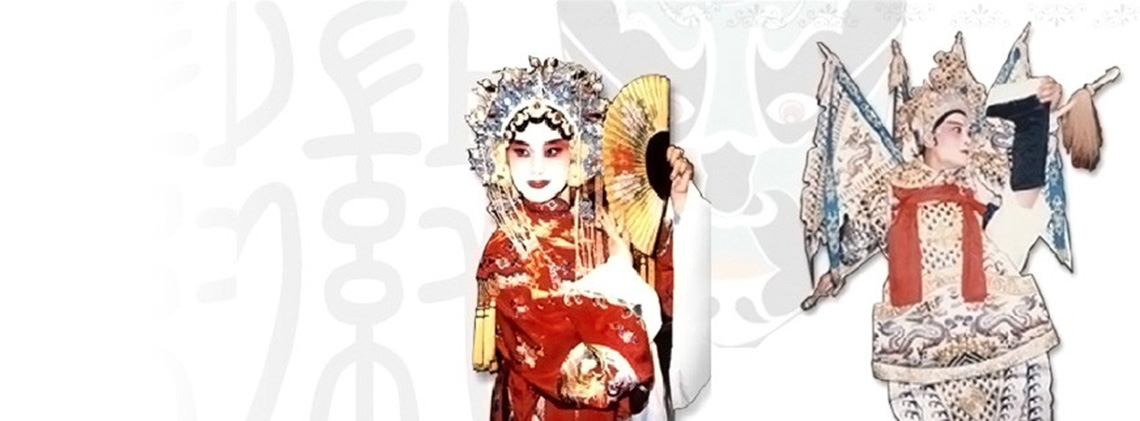
Anhui Opera
Splendid
Chi Culture
Topic
Anhui Opera
Tang Xianzu (1550–1616), the renowned Ming dynasty playwright, once said “All my life, I have been fascinated by a place, / I never dreamed that it would be Huizhou.” Ever since the Song dynasty (960–1279), Huizhou, whose ancient name was Xin’an, has been called a “cultural state” on account of its flourishing culture. This region in southern Anhui province not only gave birth to a splendid culture, including its own schools of Neo-Confucianism (Xin’an lixue), painting (Xin’an hua pai), printing, and architecture, it also gave birth to a new operatic melody—Huizhou melody opera. This new style of opera was created when Huizhou melody opera merged with Qingyang melody opera from Chizhou, a city north of Huizhou. This style was fashionable for a time and people would say that “the refined music of southern Huizhou and northern Chizhou is popular throughout the world.” This eventually became known as Anhui opera, an artistic form loved by the Huizhou people, which constantly influences Anhui culture.
Although it began over four hundred years ago, and was a powerful influence on other types of theater, the term “Anhui opera” was not used until 1956 when the Anhui Opera Troupe was established. Fifty years later, on May 20, 2006, the State Council approved for the first time the inclusion of Anhui opera on the list of National Intangible Cultural Heritage.
Its origins lay in the many theatrical troupes in Anhui province. These troupes performed the four different regional styles that were popular in the Ming dynasty (1368–1644): Yuyao, Haiyan, Yiyang and Kunshan; the latter was particularly popular. However, as a single troupe might perform all four styles, the styles eventually merged into one that, along with Hui-Chi melodies, came to be known as Anhui style.
Without these “Anhui troupes,” Anhui opera would never have arisen and matured. Mature Anhui opera was treated as an extraordinary performing art during the Qianlong (r. 1736–1795) era and subsequently spread to Yangzhou and the capital areas, where it enjoyed great fame.
Many operas in the repertoire were adapted from famous literary works. For example, Zhui Han Xin (Chasing Han Xin) was adapted from the Liang Han yanyi (Romance of the two Han); Shui yan qi jun (Attack with the flood) was adapted from the Sanguo yanyi (Romance of the Three States); Nao tiangong (Wreaking havoc in the Heavenly Palace) was adapted from Xiyou ji (Journey to the West). The repertoire began as unwritten pieces; only later, after the work was performed, might it be written down. In terms of content, the operas can be generally divided into the following categories: historical romance, family ethics, scholar-beauty romances, Qing legal dramas, and tales of gods, immortals, and the uncanny.
The performance skills of Anhui opera were based on techniques inherited from nanxi, the southern drama of the Song and Yuan period, and the Qingyang style of singing. Anhui opera also collected and blended aspects of older opera styles, including Yiyang, Kunqu, and Qin. The performance skills can be divided into two major types: singing and acting are the first type; the second is acrobatic fighting. Acrobatic fighting is the result of Anhui opera absorbing these techniques from the operas about Mulian rescuing his mother. The stage performance features acrobatic fighting, outstanding skill in martial arts, breathtakingly true to life performances, realistic facial expressions, graphical portrayals of the looks and spirit of the characters, group singing and dancing, and elaborate stage scenery. Special emphasis is placed on the embodiment of virtuosity. For example, Yang Guifei (Imperial Consort Yang) in Guifei zuijiu (The drunken imperial consort) opera uses stylized stage movements such as “lying down like a fish,” “tottering steps of a drunkard,” and “bending down” to portray Yang Guifei’s drunkenness; the main character Zhou Yu in the Lin jiang hui (Meeting by the riverside) opera performs several somersaults to show his insolence and arrogant manner.
In terms of musical style, it can be further grouped into four categories: Gao “Qingyang” style (referring to Yuexi, a generic term for high-pitched singing, as well as the high-pitched singing of Mulian drama), Anhui kun (kunquopera), those pieces accompanied by flute and plucked instruments, and Pi-Huang (Xipi and Erhuang melodies). Furthermore, in a certain sense, Anhui opera also educates through entertainment. The general public benefits from the dramas’ subtle moral influence. For example, audiences when they saw an Anhui opera troupe performing Qingfeng ting (Pavilion of gentle breeze), would gnash their teeth with anger and condemn the lead character, Zhang Jibao, who, after his appointment to an official position, refused even to recognize his adoptive parents who suffered hardships to raise him. Later, when he is struck by a lightning bolt and dies, the entire audience would applaud by shouting “Well done!” Even after the opera was over, the audience still felt great resentment toward Zhang Jiabao. It can be clearly seen that the moral ideals of these plays appeal to the general public.
More than 1,000 Anhui operas have been collected and arranged in recent years; some are hand written copies based on recollections of old operatic actors and artists. The Anhui opera repertoire with its lively singing and plain language reflects a strong and colorful folk life because most of the stories are about the lower class.



